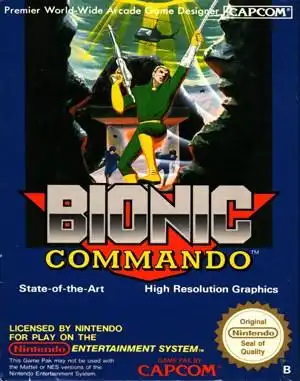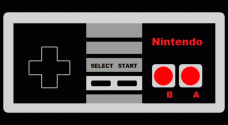Mastering the Swing: Why Bionic Commando Still Hooks Retro Gamers
Forget jumping. Seriously, just erase it from your muscle memory. When you first booted up Bionic Commando, Capcom threw the platforming rulebook out the window and handed you... an arm. A magnificent, grappling, swinging, ascending, descending bionic arm. It was weird, it was frustrating, and for many of us, it became an absolute obsession.
Released originally in arcades and then famously reimagined for the NES, Bionic Commando wasn't like other action games of the era. It demanded a new kind of navigation, a spatial awareness based entirely on extending that mechanical limb and finding something – anything – to latch onto. This unique mechanic defined the game and cemented its place as a true retro classic.
The Arm: Why No Jumping?
The most striking feature of Bionic Commando is, without question, the deliberate absence of a jump button. In a world dominated by Mario and Mega Man, this was a revolutionary (and initially infuriating) design choice. Your only vertical movement comes from the bionic arm.
Mastering the arm is the game's core challenge and its ultimate reward. You needed to learn:
- Grappling: Extending the arm to grab ceilings, platforms, or even certain enemies.
- Swinging: Building momentum to cross gaps.
- Ascending/Descending: Pulling yourself up or lowering yourself down.
- Stopping: Crucially, knowing when and how to detach to land precisely.
This mechanic wasn't just a gimmick; it dictated the level design, the enemy placement, and how you approached every single obstacle. It forced you to think differently, transforming standard platforming challenges into intricate puzzles of timing and trajectory.
Versions, Versions Everywhere
The history of Bionic Commando can be a little confusing, mainly because the arcade game and the much-loved NES version are quite different beasts.
- The Arcade Original (Top Secret): This was the starting point, a multi-directional shooter with the grappling hook mechanic. Home computer ports (like those on the C64, Amiga, and DOS) were often based on this version, with varying degrees of success and wildly different playability and sound (Tim Follin's C64 soundtrack is legendary!).
- The NES Masterpiece (Hitler no Fukkatsu: Top Secret): This is the version most retro fans remember. Capcom completely rebuilt the game, adding a non-linear world map, RPG-lite elements like equipment selection and health upgrades, communication rooms for plot details (and hilarious wiretapping), and the famous, slightly censored, story involving Super Joe and the "Badds" (thinly veiled Nazis, led by "Master-D").
- Later Iterations: The series saw sequels and remakes, including the Game Boy game, the 2009 3D title, and the excellent, modern remake of the NES game, Bionic Commando Rearmed (2008), which brought the classic gameplay to a new generation with updated graphics and features.
While the arcade ports had their charm (and sometimes amazing music), the NES version is widely considered the definitive classic, a game that took the core idea and built a richer, more engaging experience around it.
That Classic Capcom Difficulty
Let's be honest: Bionic Commando is tough. Like, really tough. Especially the NES version. Capcom was known for challenging games, and this was no exception.
Between mastering the bionic arm's sometimes finicky controls, dealing with relentless and strategically placed enemies who loved knocking you off ledges, navigating complex levels, and facing off against tricky bosses, Bionic Commando demanded patience and practice.
The lack of a save or password system in the original NES release meant failure in later levels could send you way back, adding to the high stakes and steep learning curve. But overcoming these challenges, finally nailing that impossible swing or beating that boss that had you stumped for days? Pure retro gaming bliss.
Beyond the Bionic Arm: Story, Music, and Secrets
While the gameplay is the star, Bionic Commando offered more.
- Story: The NES version had a surprisingly detailed narrative for its time, involving rescuing Super Joe (from Capcom's earlier Commando game!) and stopping Project Albatross. The communication rooms added depth and often humor, letting you eavesdrop on enemy chatter or get mission briefings.
- Censorship: The infamous changes made for the Western release, particularly altering the Nazi imagery and the game's controversial final boss and ending sequence, are a fascinating piece of gaming history.
- Music: The NES soundtrack is iconic, featuring catchy, atmospheric tunes that perfectly fit the game's mood. The different versions, especially the home computer ports, also boasted memorable (and sometimes wildly different) scores.
These elements, combined with the distinct visual style of each version, contributed to Bionic Commando's unique personality.
Playing Bionic Commando Today
Feeling nostalgic? Want to tackle that bionic arm challenge you never quite conquered? Luckily, experiencing Bionic Commando is easier than ever.
- Digital Stores: The NES version is often available on modern Nintendo platforms (like Nintendo Switch Online). The excellent Bionic Commando Rearmed is available on PC (GOG) and other digital stores, offering a fantastic way to play the classic with modern conveniences.
- Emulation: For purists wanting to experience the original arcade or specific home computer versions, emulation via programs like MAME (for arcade) or DOSBox (for DOS) and others for systems like the C64 or Amiga is an option (ensure you own the original games!).
- Archive.org: Some abandonware versions of older PC ports might be available for free play directly in your browser on sites like Archive.org.
No matter how you play it, the core challenge and unique feel of the bionic arm remain.
Why It Still Swings
Bionic Commando wasn't just a game; it was an experiment in movement. By taking away the most fundamental action in platforming, it forced players to adapt, learn, and ultimately, master a completely new way to navigate a 2D world. Its difficulty forged legends, its story had surprising depth, and its different versions sparked countless playground debates.
It’s a game that still holds up, not just as a relic of the past, but as a genuinely clever and rewarding experience. If you've never swung through its levels or if it's been decades since you last grappled with its challenge, give Bionic Commando another shot. You might just find yourself hooked all over again.
FAQ
Q: Why can't you jump in Bionic Commando? A: The game's core design revolves entirely around the protagonist's bionic arm for all movement, including vertical traversal. The developers deliberately removed the jump ability to make the grappling mechanic the central focus and challenge.
Q: Is the NES Bionic Commando the same as the arcade game? A: No, they are significantly different. While sharing the bionic arm mechanic, the NES version features a non-linear map, RPG elements, a more developed story, and unique level designs not present in the arcade original or its home computer ports.
Q: Is Bionic Commando Rearmed a remake? A: Yes, Bionic Commando Rearmed (2008) is an enhanced remake of the classic 1988 NES game, featuring updated graphics, music, new features like co-op, and modern controls while staying true to the original gameplay structure.
Q: Was Bionic Commando censored? A: Yes, the Western release of the NES game notably censored references to Nazism and Hitler (who appeared as the final boss in the Japanese version), changing symbols and character names due to content restrictions at the time.


